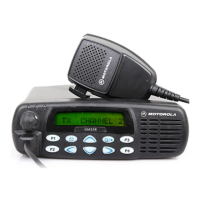Frequency Synthesis 2-9
The VCOs, together with Fractional-N synthesizer U1201, generates the required frequencies for
transmit and receive modes. The TRB line (U1201, pin 2) determines which VCO/buffer circuit is to
be enabled. A high level on TRB will turn on the transistors in U1378 to turn on via R1376, applying
the 8.3 volt VSF source to the receiver VCO and first buffer. The second buffer in each string
operates from the 9V3 source and become active when RF is applied to their inputs.
The RF signal at the bases of the second buffers are combined and fed back to the Fractional-N
synthesizer via PRE_IN where it is compared to the reference frequency as described below in
“Synthesizer Operation”. The Fractional-N IC provides a DC steering voltage VCTRL to adjust and
maintain the VCO at the correct frequency.
With a steering voltage from 2.5V to 11V at the appropriate varactor diode (CR1302 for the RX
VCO, or CR1310 for the TX VCO), the full VCO tuning range is obtained. Each VCO uses and AGC
circuit to maintain a constant VCO output level across the frequency band. A diode (CR1306 in the
receive VCO, or CR1314 in the transmit VCO) is configured as a voltage doubler which rectifies the
RF level sampled at the VCO drain and applies a proportional negative DC voltage to the VCO gate.
Increased RF level reduces the VCO gain to compensate.
The VCO output is taken from the source and applied to the first buffer transistor (Q1304 receive,
Q1307 transmit). The first buffer output is further amplified by the second buffer transistor (Q1305
receive, Q1308 transmit) before being applied to the receiver first mixer or transmitter first stage
input.
In TX mode the modulation signal coming from the LVFRAC-N synthesizer IC (MODOUT, U1201
pin 41) is superimposed on the DC steering line voltage by capacitive divider C1215, C1208 and
C1212, causing modulation of the TX VCO using the same varactor as used for frequency control.
4.3 Synthesizer Operation
The complete synthesizer subsystem comprises mainly of low voltage LVFRAC-N synthesizer IC,
Reference Oscillator (crystal oscillator with temperature compensation), charge pump circuitry, loop
filter circuitry, and voltage controlled-controlled oscillators and buffers. A sample of the VCO
operating signal PRE_IN is amplified by feedback buffer Q1202, low-pass filtered by L1205, C1222
and C1224, and fed to U1201 pin 32 (PREIN).
The pre-scaler in the synthesizer (U1201) is basically a dual modulus pre-scaler with selectable
divider ratios. The divider ratio of the pre-scaler is controlled by the loop divider, which in turn
receives its inputs via the serial interface to the microprocessor. The output of the pre-scaler is
applied to the loop divider. The output of the loop divider is connected to the phase detector, which
compares the loop divider´s output signal with the reference signal.The reference signal is
generated by dividing down the signal of the reference oscillator, whose frequency is controlled by
Y1201.
The output signal of the phase detector is a pulsed DC signal which is routed to the charge pump.
The charge pump outputs a current at pin 43 of U1201 (IOUT). The loop filter (consisting of R1205-
6, R1208, and C1212-14) transforms this current into a voltage that is applied to varactor diodes
(CR1310 for transmit, CR1302, for receive) and alters the output frequency of the appropriate
VCO.The current can be set to a value fixed in the LVFRAC-N IC or to a value determined by the
currents flowing into BIAS 1 (U1201-40) or BIAS 2 (U1201-39). The currents are set by the value of
R1211 or R1207 respectively. The selection of the three different bias sources is done by software
programming.

